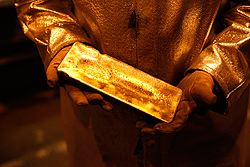Hiding Gold in All the Unusual PlacesBy Ben StevermanBloomberg Oct. 09, 2011 |
Popular 
America Last: House Bill Provides $26B for Israel, $61B for Ukraine and Zero to Secure U.S. Border

Bari Weiss' Free Speech Martyr Uri Berliner Wants FBI and Police to Spy on Pro-Palestine Activists

Telegram Founder Changed Mind on Setting Up Shop in San Francisco After Being Robbed Leaving Twitter HQ

Report: Blinken Sitting On Staff Recommendations to Sanction Israeli Military Units Linked to Killings or Rapes

MSNBC's Joy Reid Celebrates Prosecution of Trump as Racial Revenge Against Whitey
  If you’re looking for a safe place to put your investments, Chad Venzke has a suggestion: Dig a hole in the ground four feet deep, pack gold and silver in a piece of plastic PVC pipe, seal it, and bury it. If you’re looking for a safe place to put your investments, Chad Venzke has a suggestion: Dig a hole in the ground four feet deep, pack gold and silver in a piece of plastic PVC pipe, seal it, and bury it.The 30-year-old central Wisconsin resident trusts no one but himself to store and protect his gold and silver—not banks, not investment funds, and certainly not the government. It’s precisely because of this suspicion of institutions that he invests in those metals to begin with. In case of emergency, "you always want to have your precious metals within arms reach," he says. Venzke is hardly the only investor who wants his precious metals nearby at all times. A pound of gold worth about $24,000 can easily fit in a pocket; how to protect it is a decision that carries expensive consequences. Do-it-yourself investors who don't trust banks must find creative storage options, whether burying gold in the yard, submerging it in a koi pond, stashing it behind air-conditioning ducts, or placing it under carpets. All these options are debated in online gold and silver investor forums. They're also debated and demonstrated in youtube videos, including one by Venzke that has been viewed more than 7,000 times. MOUNTING HOARDS While there’s no way of knowing how many investors take Venzke’s advice, there are growing piles of precious metals in, under, or near American homes. From mid-2010 to mid-2011, U.S. investors bought up more than 100 tonnes of physical gold coins and bars, up from 15.2 tonnes in 2007, according to the World Gold Council. (A tonne, or metric ton, is 1,000 kilograms.) Worldwide bar and coin demand rose 37 percent during the mid-2010 to mid-2011 period, according to the Council, even as demand from exchange-traded funds backed by physical gold, and similar products, fell 84 percent. The notion of keeping one’s gold in a safety deposit box—inside the banks many gold aficionados find so untrustworthy—is anathema to many gold bugs. Venzke, who predicts "runaway inflation" and a crisis leading to a "new form of currency within this decade," worries that the boxes won't be accessible if banks shut down in a crisis. "How are you supposed to get your stuff out of there?" he asks. For those storing gold and silver in or around their home, the most immediate danger isn’t a crisis or a dip in metal prices. It’s theft. The FBI, which tallies the theft of precious metals and jewelry in one category, says $1.6 billion was stolen in 2010, up 51 percent from 2005. Just 4.2 percent of the lost loot was recovered last year. Metal detectors are a big worry. Basic detectors can find metal on the surface or in the first 12 inches to 14 inches below ground, depending on soil conditions, says Louis Mahnken Jr., a sales representative for Kellyco Metal Detectors in Winter Springs, Fla. That’s why Venzke advises burying it at least four feet deep. There are online debates about the best way to frustrate such thieves, including using scrap metal as decoys or hiding metal by covering it underground with asbestos or mirrors. Read More Image:Kinross Gold |



